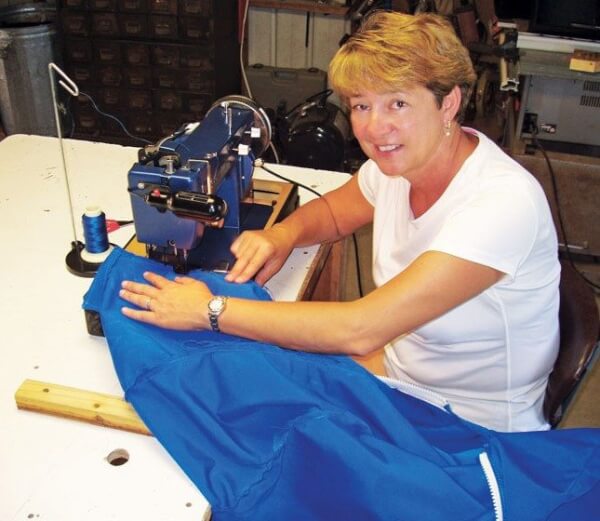Arms full of groceries; we rushed down the dock and huddled under the Bimini just seconds before the sky unleashed a deluge of rain. As we were congratulating ourselves on our perfect timing, the drops began to seep through our aging canvas.
“It really does need to be replaced,” my husband Eric said regretfully.
We had been having this discussion for the past year. Like most sailors, we are frugal; we never replace what isn’t broken. We are still using an icebox that Eric converted 18 years ago using parts salvaged from my sister’s dorm room refrigerator because it is still running. Recently retired, we were reluctant to spend next season’s cruising budget on a Bimini –even if it did leak.
“I’ll make it myself,” I said.
My last (admittedly unsuccessful) sewing experience was four decades ago, but a lack of funds is an excellent motivator. With no job and a mother-in-law who conveniently owned a Sailrite™ sewing machine, it seemed the perfect time to learn something new.
Right Information
When you know nothing about a topic, it’s good to admit it. Before I even threaded the needle of my borrowed machine, I spent hours watching free videos from Sailrite’s online DIY library. They cover everything from machine use to basic skills like stitching seams and putting in zippers. I practiced what I saw, removing and replacing zippers on old jackets and stitching together scraps of denim to become familiar with the machine and different sewing techniques.
Right Materials, Right Equipment
This is not a job I wanted to have to do again soon, so I invested in quality materials. The greatest expenditure is the fabric, but it pays to compare prices: Sunbrella™ online ranged from as little as $16.97 to $29.99 a yard for the same 46” width. Marine-grade zippers and UV thread, though more expensive than the ‘outdoor’ versions found in most fabric stores, will last longer. Sunbrella binding is also worth the cost—it saves time and gives the edges a finished look. The right needles for the job are also essential. I used the chart of recommended needle sizes for different thread types/fabrics found in the machine’s manual and ordered extra, knowing some would break.
An industrial sewing machine is the most essential piece of equipment, but some additional accessories can make the job easier. Pinning canvas is a painful and frustrating endeavor; using double-sided fabric tape allows you to effectively place zippers or fold seams without pins, leaving the tips of your fingers intact. A magnetic fabric guide is an inexpensive tool to help you maintain a straight line. My favorite, the swing-arm binder, folds the binding over the fabric’s edge and feeds both through the machine far more precisely than I could by hand.
Patterning material is also helpful, though you can make your own for free. While I took apart the original as a pattern for the Bimini, we did not have a binnacle cover and wanted one to match. I made the pattern by using a permanent marker to trace the binnacle’s outline on used plastic sheeting from an appliance purchase. After cutting out the pieces, I put them together with painter’s tape to check the fit, and then disassembled them for use as pattern pieces.
Right Space
Where you work is an important consideration. A Bimini is not a dining room table job. We cleared out space in our garage and made sure the cement floor was clean and dry, giving me enough space to lay out 50 square feet of fabric. My husband’s worktable was already well lit, but he also fitted it with a removable swinging arm to support heavy lengths of cloth so they didn’t pull down when feeding one end under the machine’s foot. He even rigged a wooden base from spare 2 X 4s to support the Bimini frame, allowing me to get a custom fit without making trips to the boat.
What Can Go Wrong?
Even armed with the right information, materials, equipment and space, things will go wrong. There are always operator errors, like stitching on seven feet of binding before realizing the bobbin is out of thread, and even the best machine is not ‘set it and forget it’. Going through heavy fabric often pounds the needle up and can force the machine itself out of proper timing. Using the instructions manual we were able to correct both of these problems, but I learned to check the needle height and timing each day before sewing to prevent dropped stitches.
Less than a month after sitting under our leaking Bimini, we installed a new replacement, along with a matching boot, and binnacle cover. We did it all – and acquired a new skill – for under $300, proving that old dogs really can learn new tricks.






